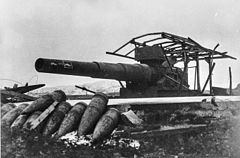24 cm Kanone (Eisenbahn)
 | |
| Dane podstawowe | |
| Państwo | |
|---|---|
| Producent | Krupp |
| Rodzaj | |
| Historia | |
| Produkcja seryjna | |
| Wyprodukowano | 6 szt. |
| Dane taktyczno-techniczne | |
| Kaliber | 238 mm |
| Długość lufy | 8500 mm (L/35,2) |
| Donośność | 10 000 m (minimalna) |
| Prędkość pocz. pocisku | 675 m/s (pocisk o masie 150 kg) |
| Długość | 20 700 |
| Masa | 94 000-95 000 kg (bojowa) |
| Kąt ostrzału | +10° do +45° (w pionie) |
| Wysokość linii ognia | 2880 mm |
| Długość odrzutu | 760-1000 mm |
| Szybkostrzelność | 1 strz./4 min. |
24 cm K. (E) Theodor Bruno - niemieckie działo kolejowe z okresu II wojny światowej. 24 cm K. (E) miało łoże kolejowe i było zasilana amunicją składaną.
Bibliografia
- Stefan Pataj: Artyleria lądowa 1872-1970. Warszawa: Wydawnictwo MON, 1975.
- Andrzej Ciepliński, Ryszard Woźniak: Encyklopedia współczesnej broni palnej. Warszawa: Wydawnictwo WiS, 1994. ISBN 83-86028-01-7.
Media użyte na tej stronie
Autor: Riksarkivet (National Archives of Norway) from Oslo, Norway, Licencja: No restrictions
Photos from Flickr album "Evakueringen og frigjøringen av Finnmark" (The Evacuation and Liberation of Finnmark, 2015) ny Riksarkivet (National Archives of Norway).
Towards the end of World War II, with Operation Nordlicht, the Germans used the scorched earth tactic in Finnmark and northern Troms to halt the Red Army. As a consequence of this, few houses survived the war, and a large part of the population was forcefully evacuated further south (Tromsø was crowded), but many people avoided evacuation by hiding in caves and mountain huts and waited until the Germans were gone, then inspected their burned homes. There were 11,000 houses, 4,700 cow sheds, 106 schools, 27 churches, and 21 hospitals burned. There were 22,000 communications lines destroyed, roads were blown up, boats destroyed, animals killed, and 1,000 children separated from their parents.
However, after taking the town of Kirkenes on 25 October 1944 (as the first town in Norway), the Red Army did not attempt further offensives in Norway. The town was handed over to Norway as the war ended. When war was over, more than 70,000 people were left homeless in Finnmark. The government imposed a temporary ban on residents returning to Finnmark because of the danger of landmines. The ban lasted until the summer of 1945 when evacuees were told that they could finally return home.
